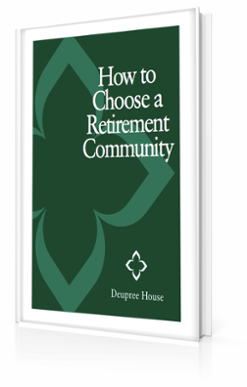
What is a continuing care retirement community (CCRC), and is it right for you? As you begin to explore options for the next chapter in your life, you may come across many different terms for communities available to older adults, from “assisted living” to “life plan community” to “CCRC.”
Many senior adults are often interested in leaving their current homes but worry that a retirement community that meets their current independent living goals might be less suitable if their health needs change.
A CCRC, or life plan community, offers the ability to join the community in an independent living community, but allows for a transition to assisted living or skilled nursing if the need arises. Not only is this situation ideal for many people, but current studies underscore the benefits.
CCRCs Encourage Healthy Lifestyles
A major longevity study conducted by Washington State University examined what factors influenced the longer lifespans of various individuals. Many of the elements they identified can be found at CCRCs.
For example, access to walking and biking trails had the apparent impact of making it easier for seniors to get the fresh-air workouts necessary for good health. Doing some kind of cardio for about half an hour most days of the week reduces your risk of developing high blood pressure, diabetes, and heart disease—while minimizing the impact if you already have it. Weight-bearing exercises like walking also reduce the effects of osteoporosis.
There’s an additional, sometimes overlooked benefit of the type of CCRC that is walkable or bikeable, according to the Washington State study. For residents for whom driving is difficult, living in a neighborhood that is near shops and services provides the elements that support a healthy lifestyle, such as medication and healthy foods.
Episcopal Church Home in Louisville, KY, is just across the street from a mixed-use business park that provides everything from massages, restaurants, salons, and yoga classes to an urgent care facility. Of course, we also have many of these services on campus for those who want to stay close to home!
So how does this add up to health in terms of “hard numbers”? Another study found that older people living in CCRC-type communities spent about 12 fewer days in the hospital than others their age and were about 75% more physically active.
Building a Sense of Community
Additional research has focused specifically on CCRCs. The Mather Institute is conducting an ongoing “Age Well Study,” which follows thousands of current residents of CCRCs across the country.
The study looked at a range of life and health situations, including a sense of connection with other people. More than two-thirds of the respondents noted that moving to a CCRC had significantly improved their social wellness.
Much like other types of wellness, social wellness is crucial for staying physically and mentally healthy. For those who move to this kind of retirement community soon after losing a spouse, the benefits of being surrounded by many people in similar situations are invaluable.
Whether single or as couples, new residents of CCRCs soon learn the benefits of a community in which activities and events are regular features. These, too, help people find like-minded friends who might enjoy book club or theater outings as much as they do.
Increased Access to Vital Services
Not surprisingly, one of the most compelling benefits of moving to a continuing care retirement community is the increased access to more health care services. It’s human nature to put off going to the doctor about a “probably nothing” wound or cough. But easy access to medical professionals keeps those minor worries from turning into significant concerns.
On the longer-term front, CCRCs tend to provide more varied health services than seniors would otherwise enjoy, including those associated with skilled nursing and memory care services. That range also means that married residents can have services customized to both members of the couple.
The Institute on Aging study found that access to the range of health and wellness services found at CCRCs resulted in an overall higher level of health than was evident in other seniors they surveyed. This included better diets, as well as an increase in other healthy behaviors.
Explore the CCRC Benefits for Yourself
Among the types of CCRC options, you may prefer an independent living situation, such as the patio homes, Episcopal Church Home’s independent option called Dudley Square.
Our newest patio homes, opened in 2023, are two-bedroom, two-bath open-concept homes are designed with popular features such as quartz countertops, premium appliances—and, of course, plenty of storage. They range from 1,600 to 2,100 square feet and feature a two-car garage and an emergency call system. We also have other homes, apartment units, and rooms as part of our CCRC range of services.
To schedule a complimentary tour, contact our Director of Community Relations, Elizabeth Pace, at (502) 736-8043 or epace@erslife.org.












